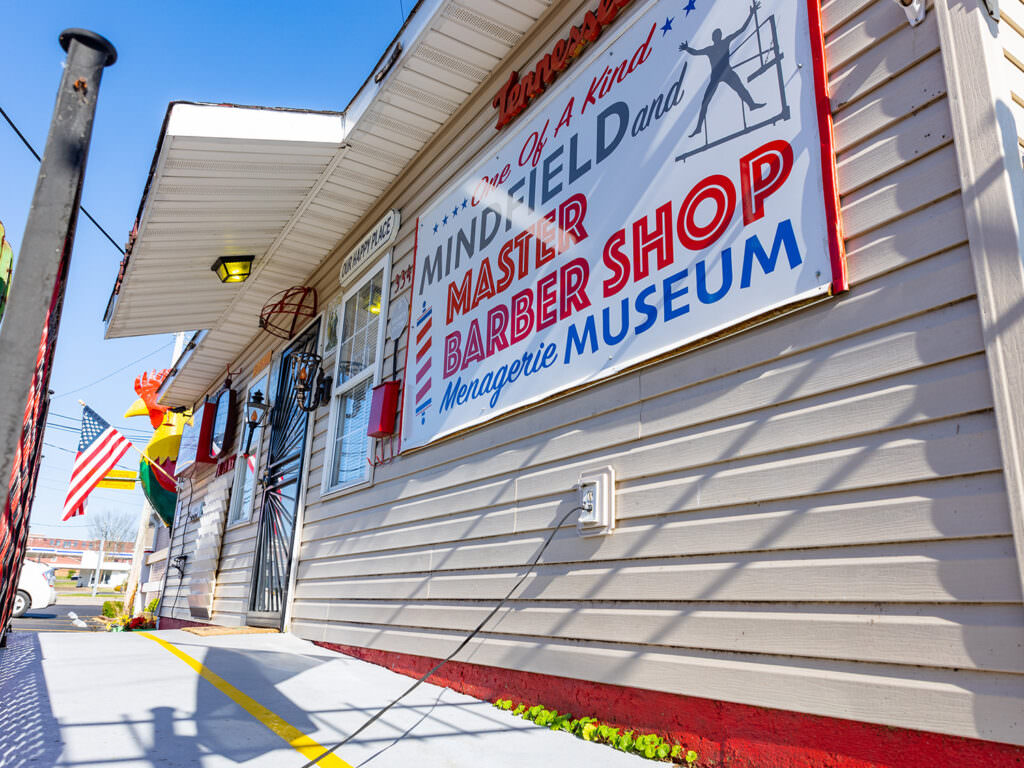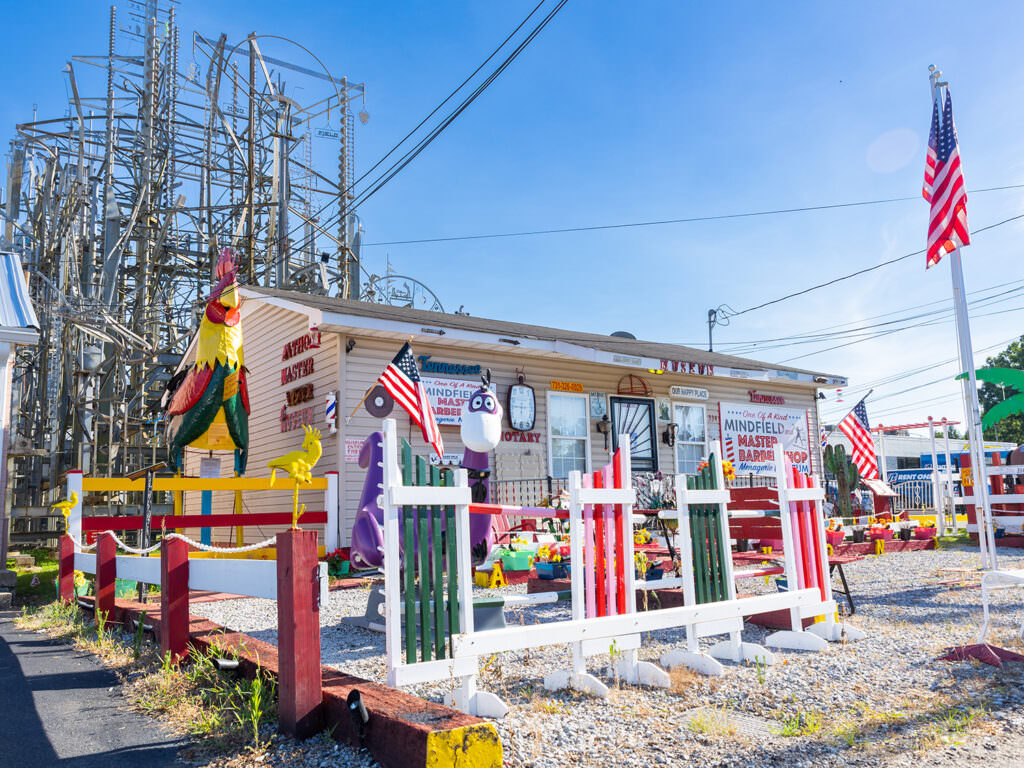Just outside of Brownsville’s quaint town square sits a hulking maze of iron – at first glance it’s a twisting vortex of steel crisscrossed by beams and punctuated with towers reaching towards the sky, sharp like teeth. But the structure reveals itself to inquiring visitors who take the time to look a bit more closely. They’ll see that it’s actually a map, a standing testament to the life of local artist and visionary Billy Tripp. Welcome to the Mindfield.
This ever-evolving work began in 1989 when a local auto parts store burned down. Tripp saw the potential of the remaining beams, which served as his initial framework for the project. Already a welder, painter, sculptor, and wood carver, he began the work of creating the Mindfield from salvaged metal. Today it includes eye-catching pieces like a water tower, the frame of a drive-in movie screen, tank treads, and even a tugboat.
A deep look at the Mindfield is a look at Tripp himself, and visitors will spot easter eggs of meaning throughout the structure that tell his story. Here’s our guide to the sculpture – and the artist.
A church and a memorial
If you look closely, you’ll find a small piece of metal hidden amongst the tangle inscribed with Tripp’s name and birth date – the death date still blank. “As I got started, I developed different themes; firstly, an outdoor church,” says Tripp. “I’m not religious, but I like things that are holy or special. And I’m going to be buried there, so [the Mindfield] is like my grave marker.”
Death and grief played significant roles in the shaping of the Mindfield; Tripp lost his mother in his early 20s and his father in 2003. Deep in the heart of the sculpture, you’ll find a poignant dedication he crafted for his family. “Before he died, I took a drawing of [my father’s] hands,” Tripp explains. “The hands up top are my brother’s and mine, and [there’s] a heart for my mom.”
The water tower, another defining feature, became a symbol of Tripp’s journey through grief. He recorded the process of erecting the tank in his journal, which was later published as part of his series of volumes entitled The Mindfield Years. “I thought, ‘I’ll use my journal to tell the story of putting the tank up, and I’ll use it to deal with my dad’s death – I’ll use the time frame of putting the tank up to do it. I don’t want to grieve forever. I want to get it done, and when I put up the tank that’s all I’m doing,’” Tripp explains. “I restarted my journal and ended up with two years and 2000 pages.”
But to Tripp, the water tower and his journal also represented something else – a journey to love and hope. “It begins in saying goodbye to dad and it ends, in part, by saying hello to what came after that,” he says. “The last six months or so of the book is when I met my wife, so it kind of came into saying hello to her, too.”
A journey with the River Horse
Observers will notice a distinctly nautical influence, a nod to the artist’s fascination with water journeys. One of the most noticeable features of the Mindfield is a shining silver canoe hung high above the words RIVER HORSE, an ode to a book of the same name by William Least Heat-Moon. Heat-Moon traveled from New York to Seattle by boat, and after corresponding with Tripp via letter for some years, the author donated his canoe to the sculpture.
The Mindfield’s journey continues as Tripp adds on to his work – he’s contemplating new aspects that evoke a big ship departing once he dies, and he plans to transform the movie screen into a kind of loading dock. “I think of it as the terminus temple,” he explains.
Finding inspiration in the Mindfield
For Tripp, creativity and art don’t have prerequisites – all you need is the passion and whatever materials and ideas are accessible to you in that moment. “I’ve got two sayings down [in the Mindfield]: ‘What I have to make, be it through what is here,’” says Tripp. “Another is ‘What I have to share, be it through my work.’”
He believes that the creative process is an essential part of self discovery and a way to better understand the world – and even the idea of divinity. “I don’t believe in what’s generally thought of as God, but I can understand for those that do, God would be around you every moment, every inch, as much as he is anywhere,” he says,”Picking up that pair of pliers or matchsticks and gluing them together – you can make those things talk about God. You can talk to God through them.”
His advice for people looking to embrace their own creativity? “If you don’t know what the next step is, look around you. Maybe you’re looking over the hill for something – you can’t see it for the hill. If you want to work with metal but don’t have a welder, you probably have a pair of pliers and a coat hanger. The first piece I made was out of coat hangers!” he explains. “And the work will grow and talk to you, if you just listen to it.”
The Mindfield, Brownsville’s unlikely tourist attraction
The Mindfield has grown slowly over the years, eventually becoming a signature part of downtown Brownsville and a certifiable tourist attraction. But Tripp never really meant for it to happen that way, nor did he think he would become a public figure. “I didn’t really make [the sculpture] to talk to other people, but I did make it to facilitate a conversation with myself,” says Tripp. “But I have learned so much indirectly from people through their work. All along I’ve felt an obligation to participate in public interviews because of that. if these people that I’ve learned from never did it themselves, I would never have read an interview from them or known them.”
Over the years, Brownsville has come to rally around the Mindfield as a town symbol, and Tripp views this as a testament to the town’s inclusive ethos. “Every community has eccentrics and oddities, things that aren’t quite mainstream,” Tripp says. “And if you can include it and make it work for the better, it’s better for everything.”
Though the Mindfield is infused with meaning for Tripp, he sees the structure as something malleable for others. “People bring their own encyclopedia of reference to things, so they’ll see things that I don’t even see. And I don’t really want to butt into what they make about it,” he says. “I hope they take away something positive, something helpful. Maybe they’ll think ‘If he can do that, I can decorate my yard – my hobby is worth my time. So what if it’s just a hobby? It means a lot to me.’”




